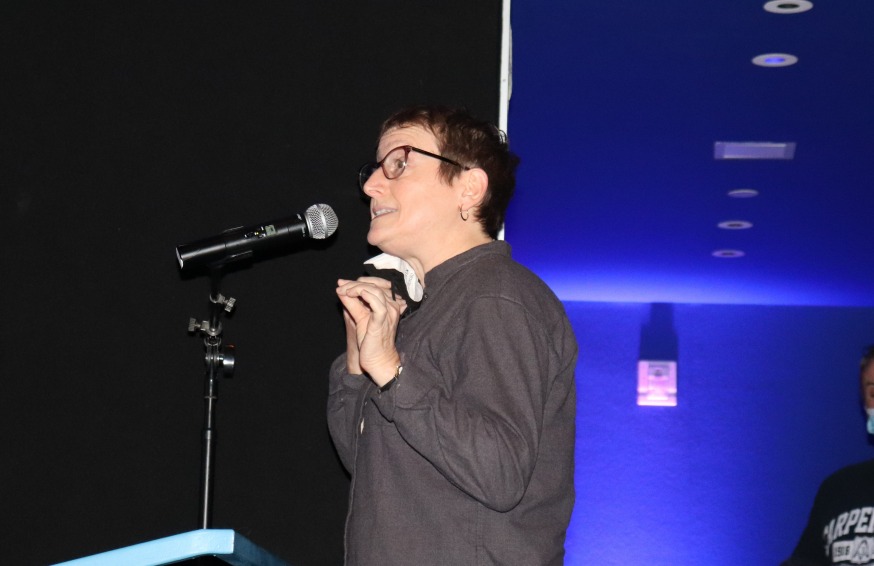
Attendees at the Innovation QNS Town Hall Wednesday (Photo by Michael Dorgan)
April 21, 2022 By Michael Dorgan
Hundreds of people turned out for a contentious town hall meeting in Astoria Wednesday night where a group of developers outlined their plans for Innovation QNS—the proposal to build nearly 3,000 apartment units in a five-block area.
The meeting was held at the Museum of Moving Image and attendees included many people in support of the project—citing jobs, the need for neighborhood revitalization and the demand for housing. A large contingent of people from a construction union were on hand advocating for the project.
Meanwhile, many activists showed up calling for the project to be scrapped arguing that it would lead to a hike in neighborhood rents and cause additional gentrification—all for the enrichment of the developers. A rally was held in opposition to the plan outside MoMI during the meeting.

Opponents of Innovation QNS speak to members of the District Council of Carpenters Wednesday urging them to oppose the plan. (Photo by Michael Dorgan)
The town hall was held by the development team—consisting of Kaufman Astoria Studios, Silverstein Properties and BedRock Real Estate Partners– who need the area rezoned in order to construct more than a dozen buildings that would range in heights from nine to 27 stories.
The meeting was prompted by Council Member Julie Won who said that the developers had not done enough to inform the public about the plan. She wrote them a letter on March 8 calling for them to hold town hall meetings, noting that many people who live nearby were unaware of the plans. Many, she said, are immigrants who don’t speak English.
The supporters came to the meeting well organized.
Members of the District Council of Carpenters came dressed in orange T-shirts and stood on the street calling on the public to support the rezoning. Meanwhile, the leaders of local non-profit organizations–such as Jacob A. Riis Neighborhood Settlement and Urban Upbound—were there to support the project.
The detractors were well also well organized.
A contingent of opponents were handing out flyers to attendees as they were lining up outside to go to the meeting. The flyers read: “Astoria is Not for Sale.” Meanwhile, a rally was planned by activists that would take place outside during the meeting.
The town hall, which consisted of two 90-minute sessions, kicked off at 4 p.m. The first session started at 4 p.m. with the second at 7 p.m.
The first session was attended by approximately 150 people, with about half of the seats in the 267-seat auditorium filled.
The developers presented their plan, armed with maps and renderings.
They walked attendees through the plan that involves creating a mixed-use district between 37th Street and Northern Boulevard, bound by 35th and 36th Avenues. The plan calls for 2,845 apartments, of which 725 would be affordable. The developers said nearly half of the affordable units would be priced below $1,000 per month.
The plan also includes 250,000 square feet of office space, 200,000 square feet of retail offerings, 100,000 square feet of community space, 2 acres of public open space, and 1,465 parking spaces.

A rendering of the Innovation QNS plan (Screenshot)

Tracey Appelbaum of BedRock Real Estate Partners (L) and Tracy Capune of Kaufman Astoria Studios (R) (Photo by Michael Dorgan, Queens Post)
Tracy Capune, vice president of Kaufman Astoria Studios, told the attendees that the plan was comprehensive and would bring many benefits to an underutilized section of Astoria. She said that many of the sites where the development is slated to go up currently consist of surface parking.
“We see our plan as an opportunity to build on the good things happening around the studio, around the museum, around the Frank Sinatra School of the Arts,” Capune said.
“Controlling five city blocks is a tremendous opportunity and a unique one to build extraordinary community amenities into our plan, amenities that address some of the challenges the neighborhood faces like open space.”

Bishop Mitchell Taylor of Urban Upbound speaking Wednesday (Photo by Michael Dorgan, Queens Post)
She also noted that housing was needed.
“There’s a citywide housing crisis,” Capune said, adding that New York needs both affordable and market-rate housing.
Meanwhile, Tracey Appelbaum of BedRock Real Estate Partners, said: “This plan really allows us to do something very cohesive and special, along with the myriad of public benefits. We planned this in a way that would add an active 24/7 district.”
Bishop Mitchell Taylor of Urban Upbound said the development would “create opportunity” and would be a “game-changer” for the community.

.
The presentation was followed by a question and answer session. Many people, however, voiced their opinion on the project– as opposed to fielding questions.
One woman condemned the plan, along with several others.
“I’ve seen what’s happened to neighborhood after neighborhood with these shiny luxury developments,” said Jenny Dubnau, a local artist. “It’s the same old story, you’re adding a tiny bit of green space…and it’s going to be for the newer, wealthier people coming in.”
“For folks who live in this community, immigrants, people of color, working-class folks, regular New Yorkers, our rents are going to rise and don’t forget the mom and pops, they’re already struggling with rents they cannot afford… rents always go up with these kinds of massive zonings.”

Jenny Dubnau, a local artist, spoke out in opposition to Innovation QNS (Photo by Michael Dorgan, Queens Post)
Meanwhile, Carolina Korth, a longtime resident of Astoria, said she is concerned that she will be priced out. “If this goes up, the ripple effect will make it so that I can no longer afford to live in this community,” Korth said.
However, Eric Benaim, a Long Island City resident and owner of the real estate firm Modern Spaces, said the development would bring many benefits to people.
“I love the fact that there’s 700 affordable units on basically empty land that has nothing there besides [empty] lots or one-story buildings, that’s going to have about 1400 people,” Benaim said.
Benaim also said that the project would increase the supply of housing and that basic economics suggests that this would help meet demand.
“When you’re offering a lot more units, guess what? Prices are going to come down.

A protester holding a sign outside the Museum of Moving Image Wednesday (Photo by Michael Dorgan, Queens Post)
A protest took place outside the museum at around 5 p.m. while the first session was taking place.
The protest brought together about 40 activists representing several groups, including CAAAV, which advocates for Asian immigrants, along with Woodside on the Move, Astoria Tenants Union, Justice For All Coalition (J4AC), Astoria Not For Sale, Western Queens Community Land Trust (WQCLT) and a broad coalition of tenants and residents.
The protesters chanted “Whose Astoria, our Astoria” and “Astoria, not for sale,” and alleged that the developers were putting their own profit ahead of the lives and livelihoods of longtime residents, workers, and small businesses. They chanted: “No Innovation QNS.”
They argued that the project would raise rents despite increasing the supply of housing. They said the development would mirror what’s taken place in Long Island City, where rents have risen despite thousands of apartments being built every year.
They noted that 75 percent of the units are at “luxury rates” and argued that the buildings are too large.
“Who is this affordable to? Who is this rezoning for?” said Hazra Rahman, a resident and CAAAV Astoria Chapter member leader. “None of the elements work towards or for us. We have seen this happening in Long Island City and Williamsburg, and we have to win here. We cannot keep letting them displace us and our people.”

Assemblymember Zohran Mamdani speaking at the protest Wednesday (Photo by Michael Dorgan, Queens Post)

Evie Hantzopoulos, Astoria resident and protester speaking Wednesday (Photo by Michael Dorgan, Queens Post)
The protest also included Assemblymember Zohran Mamdani, whose district is currently outside the planned development area—although it will include it with redistricting.
“Astoria is in the midst of a massive displacement problem,” Mamdani said. “We have been in the midst of this for decades. What we are looking at is something that will only accelerate the displacement faced by so many of my constituents.”
Several of the protesters called on Won to reject the plan when the formal rezoning process takes place. The fate of the project is largely in her hands since the rezoning—which goes through a lengthy public review process—winds up in the city council for a vote.
The developers announced the Innovation QNS plan in 2020 and have been working with the Dept. of City Planning in order to get their rezoning application certified.
The plan is expected to be certified next week, marking the start of the public review process known as ULURP.
The proposal will go before Community Board 1, the Queens Borough President, the City Planning Commission and the City Council.
The City Council vote will ultimately determine whether it is approved.

Protestor Carolina Korth holding a sign outside the Museum of Moving Image Wednesday (Photo by Michael Dorgan, Queens Post)






